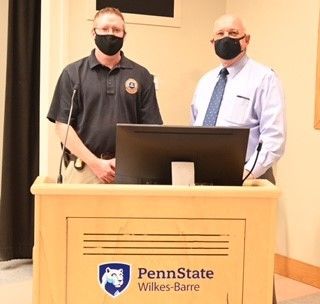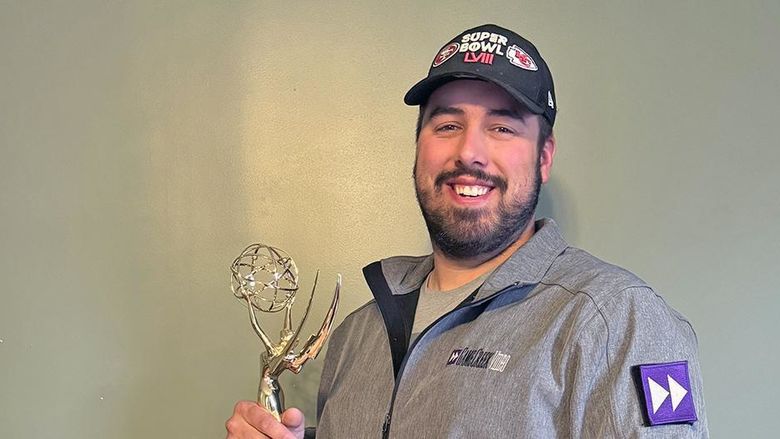
Special Agent Michael Byrnes, left, senior team leader of the Federal Bureau of Investigation (FBI)’s Evidence Response Team – Philadelphia, visited Penn State Wilkes-Barre to conduct a presentation for a forensic science class taught by Robert Jolley, right.
DALLAS, Pa. – Special Agent Michael Byrnes, senior team leader of the Federal Bureau of Investigation (FBI)’s Evidence Response Team – Philadelphia, recently visited Penn State Wilkes-Barre to conduct a presentation for a forensic science class. The course is taught by Robert Jolley, retired police chief of Dallas Township and lecturer in criminal justice at Penn State Wilkes-Barre.
During the Oct. 21 presentation, attendees learned about the forensics used in locating the bodies of four missing young men in Bucks County in 2017, as well as the arrests of those who were found responsible for the men’s deaths. Byrnes gave attendees a “look behind the curtain,” recounting his team’s involvement in recovering each of the four bodies—from the moment he received a call that his Evidence Response Team was going to be dispatched to a Bucks County farm for investigation, through and including the team’s 12-step processing of each crime scene and the eventual recovery of the young men’s remains.
Instructors at Penn State Wilkes-Barre strive to assimilate real-world experiences into their classes whenever possible, making students’ education more dynamic and engaging. A member of the FBI National Academy Associates and graduate of the 228th session of the FBI National Academy, Jolley secured the Evidence Response Team for a presentation after attending the Eastern Pennsylvania FBI National Academy Associates Conference in State College this summer.
“I was fortunate enough to hear the presentation, learning about the extraordinary processing of this Bucks County crime scene,” said Jolley. “It was beneficial that my class was able to experience it, too.”
Students shared Jolley’s interest, finding the presentation to be an excellent extension of what they’re learning in class.
“In Professor Jolley’s class, we talk about evidence handling and search procedures, like how to properly secure a crime scene for investigation,” said Ethan Grzymski, a second-year student at Penn State Wilkes-Barre. “It was interesting to see how the FBI puts into practice everything that we’ve learned and just how detailed they need to be when processing a scene.”
Kyler Burke, a first-year student on the 2+2 plan, and Ally Young, a senior at Lake-Lehman Jr./Sr. High School who is enrolled in Penn State Wilkes-Barre’s Dual Enrollment Program, said they found the photographs Byrnes shared to be among the most interesting parts of the presentation because they are visual learners.
“I’ve watched crime shows on television my whole life,” said Burke. “But crime shows are often much more theatrical. This presentation was interesting to me because it was very factual, and we got to see real photographs taken in the moment, just as the scenes were being investigated. You don’t get all that background perspective when you watch TV.”
Young said, “Because I’m doing dual enrollment, I’m getting a head start on college. I really feel that this class is helping me get a leg up while learning in the way I prefer. Getting to see pictures and physical evidence and knowing that these professionals are speaking from real-life experiences they’ve had — all of that makes the class that much more interesting.”
When asked how presentations like his contribute to students’ criminal justice education at Penn State Wilkes-Barre, Byrnes said that bringing those real-world learning points into his presentations is critical.
“I try to connect what they’re learning through a real-life case study,” he said. “In Jolley’s class, students are learning about the importance of crime scene documentation, so that was a key focus area for us.”
In addition to students, local law enforcement officers were also invited to the presentation and partook in a question-and-answer session with Byrnes following his talk. A representative from the FBI shared that this was the first time Byrnes’ presentation was being recorded and that it will be used in future trainings for FBI representatives, police officers and other groups.
Byrnes has spent 25 years with the FBI as an Evidence Response Team leader and has processed other notable crime scenes including those of the Sept. 11 attacks, Boston Marathon bombing and Westgate Mall attack in Nairobi, Kenya.





